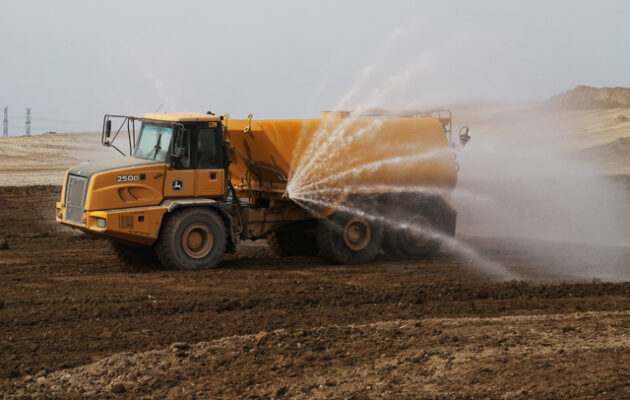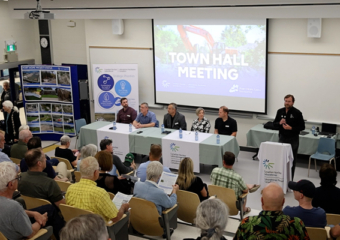With increased temperatures in the summer months, the ground often dries out leading to dusty conditions. It’s especially noticeable on the side of the roads and in sandy areas where there is limited grass or plant coverage. Additionally, dust generating activities are often present on construction sites and therefore managing and controlling dust is an ongoing task for every construction project.
Canadian Nuclear Laboratories (CNL) works to prevent, control and monitor dust during the cleanup and restoration phases of Port Hope Area Initiative (PHAI) activities. Each site must have a dust management plan for PHAI work that determines action, roles and responsibilities and includes real-time monitoring of dust levels.
CNL recognizes that uncontrolled dust can be both a nuisance and a potential hazard. It is important to note that dust generated on PHAI sites does not need to contain historic low-level radioactive waste (LLRW) to prompt the implementation of dust prevention and control measures. PHAI dust management strategies include the use of water trucks to dampen soil or exposed areas, the direct application of dust suppressants and the recently added use of an industrial fogger.
 At the Port Hope Harbour, an industrial fogger is now being used near the sediment processing area, in which Portland cement is mixed with sediment dredged from the harbour to assist in shipping. This activity can cause visible dust. The fogger, or industrial misting unit, is a state-of-the-art machine used to control visible airborne dust. It pushes water out with air and atomizes the water droplets. The mist generated by the fogger may look a little like dust to the naked eye but the mist is actually taking dust right out of the air.
At the Port Hope Harbour, an industrial fogger is now being used near the sediment processing area, in which Portland cement is mixed with sediment dredged from the harbour to assist in shipping. This activity can cause visible dust. The fogger, or industrial misting unit, is a state-of-the-art machine used to control visible airborne dust. It pushes water out with air and atomizes the water droplets. The mist generated by the fogger may look a little like dust to the naked eye but the mist is actually taking dust right out of the air.
At the Highland Drive Landfill where odour is also a concern, advanced foam technology solutions are used to control dust. This biodegradable foam is used as a daily cover to suppress both dust and odour and acts a barrier on the waste to prevent blowing litter and scavengers. The foam poses no threat to workers, neighboring residents, wildlife or ground water.
While direct water application to dusty areas on project sites is effective for reducing dust, this can create mud that adheres to wheels. Many sites use a mud matt made of stones that the trucks roll over near the exit to help knock mud off the tires before they reach the public roadway. To ensure that contaminated soil is not tracked on to roadways, trucks transporting LLRW from sites to long-term storage are monitored before every trip.
Street cleaners are also used regularly near active PHAI sites to remove any mud and dirt from restoration activities (clean fill) inadvertently tracked on to the roads. This helps to prevent mud on the roads from becoming airborne dust when it dries. The trucks are sometimes damp as a result of the road cleaning efforts which may result in dust from the roadside adhering to them while they are traveling in town or on the highway, causing them to look dusty.
CNL environmental technicians regularly use hand held air monitoring devices to check for dust and high quality air monitors are active on all PHAI sites as part of CNL’s environmental monitoring program.
For more information on CNL dust monitoring, visit here. For more information on the PHAI cleanup, please connect with us at 905.885.0291 or [email protected]




